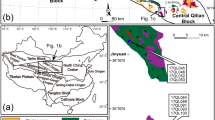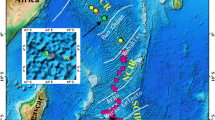Abstract
In the Brévenne Series (NE Massif Central), a low-grade bimodal association of metabasalts and metarhyolites is exposed, together with intrusive trondhjemite bodies. Zircon U-Pb dating constrains their magmatic emplacement at 366 ± 5 Ma and 358 ± 1 Ma, respectively. The metabasalts are characterized by a distinct enrichment in incompatible elements (e.g. Th and LREE) and positive ɛNdi (from +5 to +8). Combined isotope and trace element systematics rule out crustal contamination of mafic melts as a suitable cause of the LILE (large ion lithophile element)-enrichment. Rather, a mixing process between a component similar to mid ocean ridge basalts and an enriched end-member with ɛNdi > +5 is suggested. An enriched-mantle source of ocean island basalt affinity is precluded by the relative depletion of high field strength elements, especially Nb which shows negative anomalies in chondrite-normalized patterns. On the contrary, a subduction-related origin for the LILE enrichment would be more consistent. It may be inferred that arc-like melts [enriched in Th and LREE (light rare earth elements) and depleted in Nb, with ɛNdi > +5] were produced through partial melting of a depleted-mantle source, to which a small amount of crustally derived component had been added. The metarhyolites are enriched in LILE, and have a close genetic relationship with the metabasalts, as evidenced by their high ɛNdi (from +4.7 to +6.8). Although the chemical evidence remains ambiguous, it is suggested that fractional crystallization, accompanied by subordinate assimilation, is the petrogenetic process most consistent with the data. The trondhjemites are isotopically distinct from the metarhyolites. Their ɛNdi values (from −1.0 to +2.2) reflect an important contribution of continental crust to their genesis, and disprove their inferred cogenetism with the felsic volcanics. A review of modern environments in which such bimodal suites are exposed, shows that settings involving incipient rifting of a volcanic arc fringing a continental margin, or built upon young, thin continental crust might provide suitable analogues. Geodynamic reconstructions are complicated by subsequent tectonic events which disrupted the initial patterns, and by Mesozoic-Cenozoic sedimentary cover. However, this subduction-related magmatism enlarges the growing body of evidence for southward subduction processes until the Late Devonian during the evolution of the northern flank of the European Variscides. As a general implication, it is suggested that the combined use of the Sm-Nd system with incompatible elements relatively resistant during alteration and low-grade metamorphism (REE, Th, Zr, Nb) may provide diagnostic criteria for recognizing the tectonic setting of bimodal metaigneous suites in ancient orogenic belts.
Similar content being viewed by others
Author information
Authors and Affiliations
Additional information
Received: 21 April 1997 / Accepted: 30 June 1997
Rights and permissions
About this article
Cite this article
Pin, C., Paquette, JL. A mantle-derived bimodal suite in the Hercynian Belt: Nd isotope and trace element evidence for a subduction-related rift origin of the Late Devonian Brévenne metavolcanics, Massif Central (France). Contrib Mineral Petrol 129, 222–238 (1997). https://doi.org/10.1007/s004100050334
Issue Date:
DOI: https://doi.org/10.1007/s004100050334




